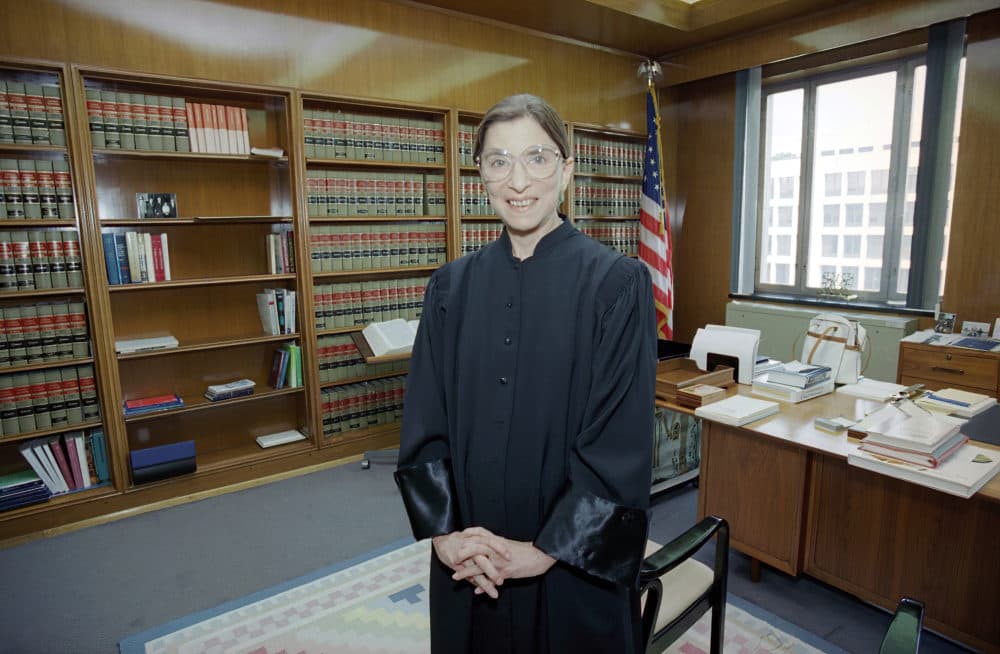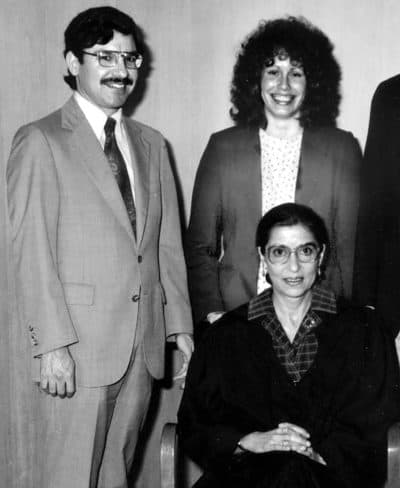Advertisement
Ruth Bader Ginsburg's Death Marks 'The Last Of An Era' For The Supreme Court, Former Clerk Says

In the 1970s, Here & Now host Robin Young signed a contract for work that said she couldn’t get pregnant or otherwise disfigured. And in the ‘60s, Young recalls how the law prevented her mother from getting a credit card.
No one took this gender discrimination on the way the late Justice Ruth Bader Ginsburg did.

Jonathan Entin worked as her legal clerk in the 1980s when she was on the U.S. Court of Appeals for the D.C. Circuit Court. Now a professor emeritus of law and adjunct professor of political science at Case Western Reserve University, he says all of Ginsburg’s clerks were part of her family and vice versa.
“I would not be the person I am, I would not have had the career that I've had without having been part of Justice Ginsburg's judicial family,” he says. “I do not have words to say how important that has been to me."
Ginsburg's death serves as an institutional loss for the Supreme Court and the United States, he says.
Over 100 former clerks lined the steps of the Supreme Court to receive Ginsburg’s casket on Wednesday. Though he’s not a sentimental person, Entin says the image made it difficult to control his emotions.
Entin applied to work for Ginsburg because of the work she did before her nomination to the D.C. Circuit Court as the “architect of a litigation campaign that resulted in a series of landmark Supreme Court rulings prohibiting gender discrimination.”
One case involved an 1873 law that allowed Illinois to ban women from becoming lawyers because they were too fragile — and the creator deemed that their paramount destiny was to serve as wives and mothers.
And a 1908 Oregon law limited the number of hours that women could work. The law relied on Justice Louis Brandeis to support the notion that women needed protection to avoid harming their reproductive function.
Advertisement
Brandeis made his argument in-part because of other Supreme Court decisions that said states could not limit anyone’s working hours, aiming to “chip away” at rulings that outraged him, Entin says.
“But in doing so, he made an argument that bought into the stereotype that women were too fragile to get out in the real world and work,” Entin says. “And that meant that women had many fewer opportunities than men did.”
The case of Reed v. Reed challenged an Idaho law that required probate courts to appoint men to administer estates even if there was a qualified woman.
When the teenage son of a long-divorced couple died by suicide, both the parents wanted to administer their son’s small estate. But the judge appointed the father because of the state law.
The case was appealed to the Supreme Court, and Ginsburg wrote the brief. Before this breakthrough case, the court had never ruled this type of gender-based law unconstitutional, Entin says.
“Then-professor Ginsburg understood that this kind of small-looking case could be the opportunity to make some good law,” he says. “And in fact, that's what happened.”
Ginsburg understood that laws that restricted women’s opportunities or rights also impacted men. Part of the reason she understood this so well was her “wonderfully supportive” husband, Martin Ginsburg, Entin says. After meeting in college, Martin Ginsburg supported her work for all his life.
But Ginsburg was also a “brilliant” lawyer who knew she needed to make her arguments in front of a group of nine middle-aged and older men, Entin says.
“And so she thought, ‘I need to persuade these folks that I've got a serious legal argument,’ ” he says. “What better way to do that than by showing them that assumptions about what was a male function and what was a female function might influence them as well?”
In Ginsburg’s first appearance before the Supreme Court as a lawyer, she appeared on behalf of Air Force Lieutenant Sharron Frontiero, who was required by law to prove that her husband was dependent on her for more than half of his support in order for him to get housing, medical and dental benefits. Men in the military did not have to do that for their wives.
Ginsburg felt nervous before the appearance, he recalls, but felt a “jolt of energy” when she began the argument. She convinced four justices to say the court should evaluate gender-based laws in the same way as race-based legislation — which is “almost always invalid,” he says.
“But for several of the justices, the analogy to racial discrimination was a step too far,” he says. “She took these cases incrementally to try to expand on the legal doctrine that she was trying to get the court to endorse.”
Even if Justice Ginsburg never served on the Supreme Court, Entin says the legacy that lies within these cases would still make her “a person of enormous historic significance.”
But in today’s political climate, justices get appointed to the highest court in the land by aligning with the views of one party and sticking with those beliefs, he says.
“The loss of Justice Ginsburg is not just the loss of a jurist of historic stature, as Chief Justice [John] Roberts has put it. In a way, we've seen the last of an era in the kinds of people who wind up on the Supreme Court,” he says. “And I think that's a loss for the court and I think it's a loss for the country.”
Chris Bentley and Karyn Miller-Medzon produced and edited this interview for broadcast with Peter O'Dowd. Allison Hagan adapted it for the web.
This article was originally published on September 24, 2020.
This segment aired on September 24, 2020.

